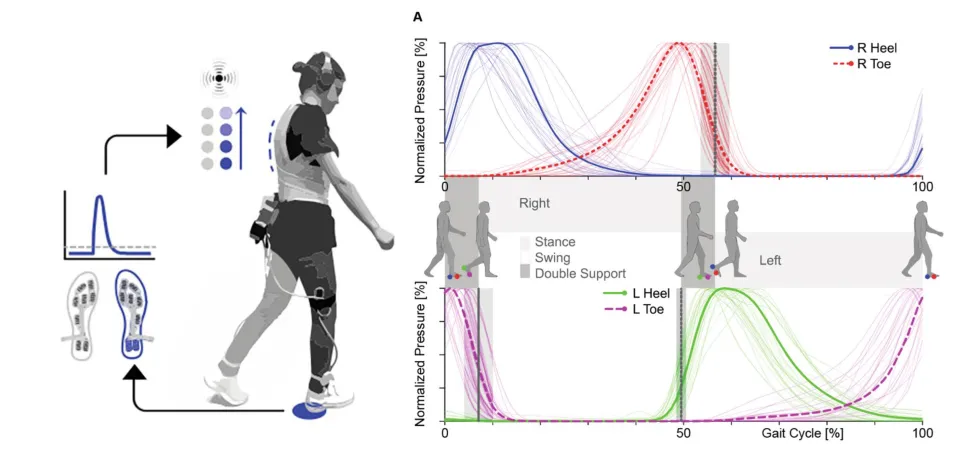- Accueil
- Le centre
- Recherche et innovation
- Centre de médecine virtuelle
- Consultation de santé cérébrale et mentale
Neurocentre
Neurocentre
Neurocentre
Neurocentre

Notre étude comportementale sur la perception locomotrice a été publiée dans le Journal of Neurorehabilitation and Engineering. Dans cette étude, dirigée par le Dr Atena Jouybari du Laboratoire de neurosciences cognitives de l'EPFL, nous avons fourni à des participants en bonne santé un retour d'information sur leur mouvement en transférant la sensation de leurs pas sur leur propre dos par le biais d'une veste tactile. Notre étude démontre que les participants perçoivent cette information comme correspondant à leur mouvement en cours et pourrait ouvrir une nouvelle voie dans l'utilisation de ce type de technologie pour les populations de patients ayant des difficultés locomotrices.
Abstract
Background
Sensory reafferents are crucial to correct our posture and movements, both reflexively and in a cognitively driven manner. They are also integral to developing and maintaining a sense of agency for our actions. In cases of compromised reafferents, such as for persons with amputated or congenitally missing limbs, or diseases of the peripheral and central nervous systems, augmented sensory feedback therefore has the potential for a strong, neurorehabilitative impact. We here developed an untethered vibrotactile garment that provides walking-related sensory feedback remapped non-invasively to the wearer’s back. Using the so-called FeetBack system, we investigated if healthy individuals perceive synchronous remapped feedback as corresponding to their own movement (motor awareness) and how temporal delays in tactile locomotor feedback affect both motor awareness and walking characteristics (adaptation).
Methods
We designed the system to remap somatosensory information from the foot-soles of healthy participants (N = 29), using vibrotactile apparent movement, to two linear arrays of vibrators mounted ipsilaterally on the back. This mimics the translation of the centre-of-mass over each foot during stance-phase. The intervention included trials with real-time or delayed feedback, resulting in a total of 120 trials and approximately 750 step-cycles, i.e. 1500 steps, per participant. Based on previous work, experimental delays ranged from 0ms to 1500ms to include up to a full step-cycle (baseline stride-time: µ = 1144 ± 9ms, range 986-1379ms). After each trial participants were asked to report their motor awareness.
Results
Participants reported high correspondence between their movement and the remapped feedback for real-time trials (85 ± 3%, µ ± σ), and lowest correspondence for trials with left-right reversed feedback (22 ± 6% at 600ms delay). Participants further reported high correspondence of trials delayed by a full gait-cycle (78 ± 4% at 1200ms delay), such that the modulation of motor awareness is best expressed as a sinusoidal relationship reflecting the phase-shifts between actual and remapped tactile feedback (cos model: 38% reduction of residual sum of squares (RSS) compared to linear fit, p < 0.001). The temporal delay systematically but only moderately modulated participant stride-time in a sinusoidal fashion (3% reduction of RSS compared a linear fit, p < 0.01).
Conclusions
We here demonstrate that lateralized, remapped haptic feedback modulates motor awareness in a systematic, gait-cycle dependent manner. Based on this approach, the FeetBack system was used to provide augmented sensory information pertinent to the user’s on-going movement such that they reported high motor awareness for (re)synchronized feedback of their movements. While motor adaptation was limited in the current cohort of healthy participants, the next step will be to evaluate if individuals with a compromised peripheral nervous system, as well as those with conditions of the central nervous system such as Parkinson’s Disease, may benefit from the FeetBack system, both for maintaining a sense of agency over their movements as well as for systematic gait-adaptation in response to the remapped, self-paced, rhythmic feedback.